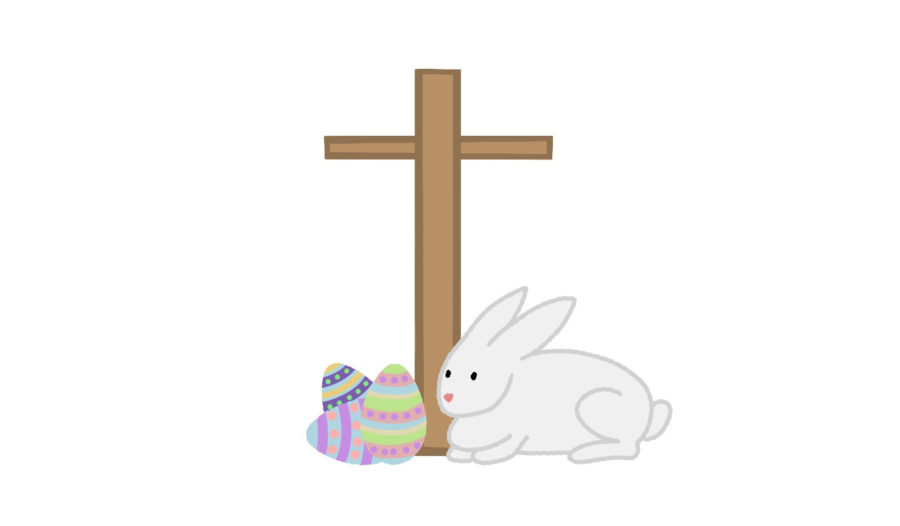Origins and Traditions of Easter
Easter is a holiday that has been celebrated throughout the world for hundreds of years. But what is the true history behind it?
Photo courtesy of pantherprowler.org
Easter Sunday is celebrated both religiously and not.
April 2, 2021
Easter, whether carried out in a religious or celebratory fashion, is one of the major holidays during the course of the spring months. Once the first day of spring hits, families who look forward to this special holiday decorate their houses with pastel colors, design intricate Easter eggs, and begin preparations for a glorious feast. This holiday, however, includes history that goes back to roughly 30 A.D and is not traditionally a day to celebrate the Easter Bunny, but rather the resurrection of Jesus Christ.
Celebrations of Easter Sunday actually begin many weeks before the actual date with a forty-day fasting period called Lent. This sacrificial practice states that every Christian that is of the age of fourteen and above must not consume meat on Fridays during Lent. However, some dedicated Christians choose to give up more items they love in order to replicate Jesus Christ’s sacrifice and withdrawal He experienced while in the desert for forty days.
Ash Wednesday initiates the Lent season and is a day set aside for the examination of one’s morality as well as the repentance of one’s sins. Ashes are created by burning the palms used during the former year’s Palm Sunday and priests create a cross using the ash on the foreheads of churchgoers.
The final week before Easter, also known as Holy Week in the Christian church, includes five days that each serves to remember the significant events that led to the death of Jesus Christ. Palm Sunday, the first day of this Holy Week, commemorates the day described in the Bible where Jesus rode into Jerusalem by donkey and was greeted by a large crowd who laid palm branches to showcase their dedication to their Savior and King. To honor this story, Christians are given palms at church and bless on Palm Sunday.
Maundy Thursday, also known as Holy Thursday, honors the Last Supper where Jesus established the sacrament of Holy Communion, which is still used in services every day around the world today. This is known to be the final meal that Jesus had with His twelve Disciples. During this day of remembrance, Christians attend a special service that focuses its attention on the Eucharist, which symbolizes the body and blood of Jesus Christ.
Good Friday is traditionally a day that commemorates the suffering and Crucifixion of Jesus Christ. Many Christians spend this very passionate day in penance, praying, fasting, and attending services that honor His death on the cross. Immediately following Good Friday is Holy Saturday, which is a day to celebrate the long vigil that the followers of Jesus Christ held outside of His tomb when he was buried.
At the end of Holy Week is the Christian holiday, Easter. Easter is traditionally celebrated by Christians across the world who believe Jesus Christ resurrected from the dead three days after He was crucified. The day is filled with joyous Easter services, candlelight, the ringing of bells at churches, and the celebration to memorialize that Jesus has risen once again.
Although Easter has obvious religious significance, it also is celebrated in a non-religious way.
In many homes in the world, the Easter Bunny is known as the ultimate delivery of goodies. Children wake up that Sunday morning to find that the character has delivered candy and chocolate. But what does this have to do with Jesus resurrecting from the dead?
The Bible does not mention anything about a bunny rabbit delivering these treats to children on Easter Sunday. However, the Easter bunny has become a commercialized symbol of the holiday. Although there is no proof of when and if exactly this occurred, historians believe that the tradition of the Easter Bunny originated in America in the 1700s by immigrants from Germany. The people of Germany are said to have brought the tradition of their egg-laying hare named “Oschter Haws” or “Osterhase” to the United States. This German custom spread throughout the United States like a wildfire and it is believed to have eventually evolved into the delivery of chocolate, candy, and gifts we see today.
It is also speculated that from a religious standpoint, eggs, the symbol of new life, are used to represent Jesus’ exit from His tomb. In addition, it is also believed that eggs were once a food item not to be eaten during the season of Lent. Therefore, people would decorate the eggs in a beautiful manner and eat them on Easter as a celebration of the fasting period. This is also the case for the chocolate egg or bunny that children receive. Chocolate is a common sacrifice that Christians choose for Lent, so eating the ever so wonderful chocolate bunny on Easter is a delicious reward.
No matter the origin of these modernized Easter traditions and symbols, it is no doubt that Easter is both a religious holiday for Christians and a commercial event targeted towards young children.












